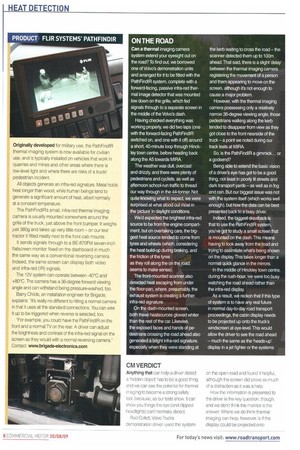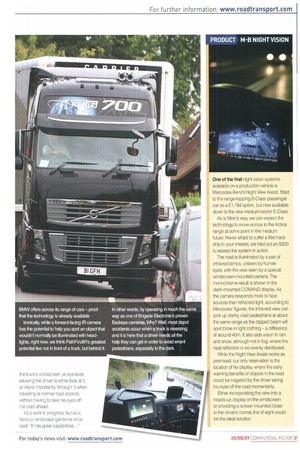ON THE ROAD
Page 38

Page 39

If you've noticed an error in this article please click here to report it so we can fix it.
Can a thermal imaging camera system extend your eyesight out on the road? To find out, we borrowed one of Volvo's demonstration units and arranged for it to be fitted with the PathRndIR system, complete with a forward-facing. passive infra-red thermal image detector that was mounted low down on the grille. which fed signals through to a separate screen in the middle of the Volvo's dash Having checked everything was working properly, we did two laps (one with the forward-facing PathFindIR switched on, and one with it off) around a short, 40-minute loop through Hinckley town centre, before heading back along the A5 towards MIRA.
The weather was dull. overcast and drizzly, and there were plenty of pedestrians and cyclists, as well as afternoon school-run traffic to thread our way through in the 44-tonner. Not quite knowing what to expect, we were surprised at what stood out most in the 'picture in daylight conditions We'd expected the brightest infra-red source to be from the engine compartment. but on overtaking cars. the biggest heat source tended to come from tyres and wheels (which, considering the heat build-up during braking, and the friction of the tyres as they roll along the on the road. seems to make sense).
The front-mounted scanner also detected heat escaping from under the floor-pan, where, presumably. the exhaust system is creating a further infra-red signature.
On the dash-mounted screen, both these heatsources glowed whiter than the rest of the car. Likewise, the exposed faces and hands of pedestrians crossing the road ahead also generated a bright infra-red signature, especially when they were standing at the kerb waiting to cross the road — the scanner detected them up to 100m ahead That said, there is a slight 'delay' between the thermal imaging camera registering the movement of a person and them appearing to move on the screen, although it's not enough to cause a major problem.
However, with the thermal imaging camera possessing only a relatively narrow 36-degree viewing angle, those pedestrians walking along the kerb tended to disappear from view as they got close to the front nearside of the truck — a point we noted during our track tests at MIRA.
So, is the PathAndIR a gimmick... or a godsend?
Being able to extend the basic vision of a driver's eye has got to be a good thing, not least in poorly lit streets and dark transport yards — as well as in fog and rain. But our biggest issue was not with the system itself (which works well enough). but how the data can be best presented back to a busy driver.
Indeed the biggest drawback is that to use the Path FindIR system, you've got to study a small screen that is mounted on the dash This means having to look away from the road and trying to assimilate what's being shown on the display. This takes longer than a normal quick glance in the mirrors.
In the middle of Hinckley town centre. during the rush-hour. we were too busy watching the road ahead rather than the infra-red display.
As a result, we reckon that if this type of system is to have any real future in normal day-to-day road transport proceedings, the cabin display needs to be projected up onto the truck's windscreen at eye-level.This would allow the driver to see the road ahead — much the same as the 'heads-up' display in a jet fighter or the systems BMW offers across its range of cars proof that the technology is already available Ironically, while a forward-facing IA camera has the potential to help you spot an object that wouldn't normally be illuminated with headlights, right now, we think PathFindIR's greatest potential lies not in front of a truck, but behind it. In other words, by operating in much the same way as one of Brigade Electronic's proven Backeye cameras Why? Well, most depot accidents occur when a truck is reversing; and it is here that a driver needs all the help they can get in order to avoid errant pedestrians, especially in the dark




































































































































